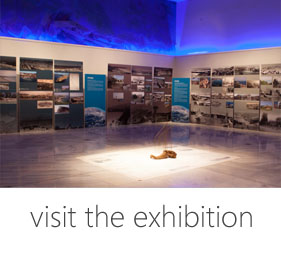Exhibition /
Thessaloniki
Opening of the Photographic Exhibition in Thessaloniki, Greece
“MEDIEVAL PORTS IN THE MARITIME ROUTES OF THE EAST:
NORTH AEGEAN, BLACK SEA, CASPIAN SEA”
From the very first days since its opening the photographic exhibition "Medieval Ports in the Maritime Routes of the East. North Aegean, Black Sea, Caspian Sea" attracts a great interest from the public. The exhibition was inaugurated on Saturday 15th December 2012 in the Hall of Temporary Exhibitions of the Museum of Byzantine Culture in Thessaloniki.
The exhibition is organized by the European Centre of Byzantine and Post Byzantine Monuments (E.K.B.M.M.) in cooperation with the Cultural Centre of the Region of Central Macedonia and the Centre for Study and Development of Greek Civilization of the Black Sea. It is included in the actions of the Project "OLKAS: From the Aegean to the Black Sea. Medieval Ports in the Maritime Routes of the East".
Until now schools and individuals from Greece and abroad have expressed their intention to visit the exhibition, interested in learning about the history and the culture that developed in the ports of the three seas.
Referring particularly to the impressive interest in the exhibition, the scientific coordinator, archaeologist Dr. Flora Karagianni, notes: "It is astonishing that from the early days of the exhibition, citizens and public schools have expressed strong interest in it. For us it is very hopeful that people of all ages want to learn more about the Byzantine-Medieval times in the Black Sea region".
The opening of the exhibition was attended by the Minister of Macedonia and Thrace Mr Theodoros Karaoglou, the Head of the Metropolitan Area of Thessaloniki-Region of Central Macedonia Mr Apostolos Tzitzikostas, the Mayor of Thessaloniki Mr Yiannis Boutaris, representatives of the General Consulate of the Republic of Bulgaria and of the General Consulate of Georgia, representative of the North Aegean Maritime Administration, representatives of local authorities, a representative team of the National Archives of the Ministry of Justice of Georgia, byzantinologists from Greece and abroad, private collectors and people who were highly interested in photos, documents and maps of the ports.
Basic speaker on the topic and the philosophy of the project was the scientific coordinator, archaeologist Dr. Flora Karagianni, who marked that the exhibition will "travel" and will be hosted within the next year in Istanbul, Odessa, Constanta and elsewhere. Describing the project "OLKAS", Dr Karagianni announced the upcoming launch of a website about the culture and tourist attractions of 39 medieval ports, from Thessaloniki to Baku, as well as the production of a documentary and the organization of an International Scientific Conference in 2013, in Thessaloniki.
The representative of Cultural Center of Thessaloniki which participates in project "OLKAS", Christina Kelesidou, noted the importance of the exhibition and of the whole project for the creative coexistence in the area where the ship "Olkas" was traveling.
The project “OLKAS” is funded by the European program «Joint Operational Program "BLACK SEA 2007-2013"» and by national resources and is coordinated by the European Centre of Byzantine and Post Byzantine Monuments (E.K.B.M.M.). Its focus is to create an inter-state cooperation network among the Black Sea countries, to record and promote the common medieval cultural heritage and to develop cultural tourism. Six Black Sea region countries including Greece, Turkey, Ukraine, Bulgaria, Romania and Georgia have undertaken the study, promotion and enhancement of the medieval cultural heritage of each country.
For more information:
Dr. Flora Karagianni (Ε.Κ.Β.Μ.Μ.), +30 2310 889830, +30 6977552529
E-mail contact: info@ekbmm.gr
Duration of the exhibition: 15 December 2012 – 15 January 2013 (extended until 31 March 2013)
Place of the exhibition: Museum of Byzantine Culture, Hall of Temporary Exhibitions “Kyriakos Krokos”, Leoforos Stratou 2, Thessaloniki, Greece




















